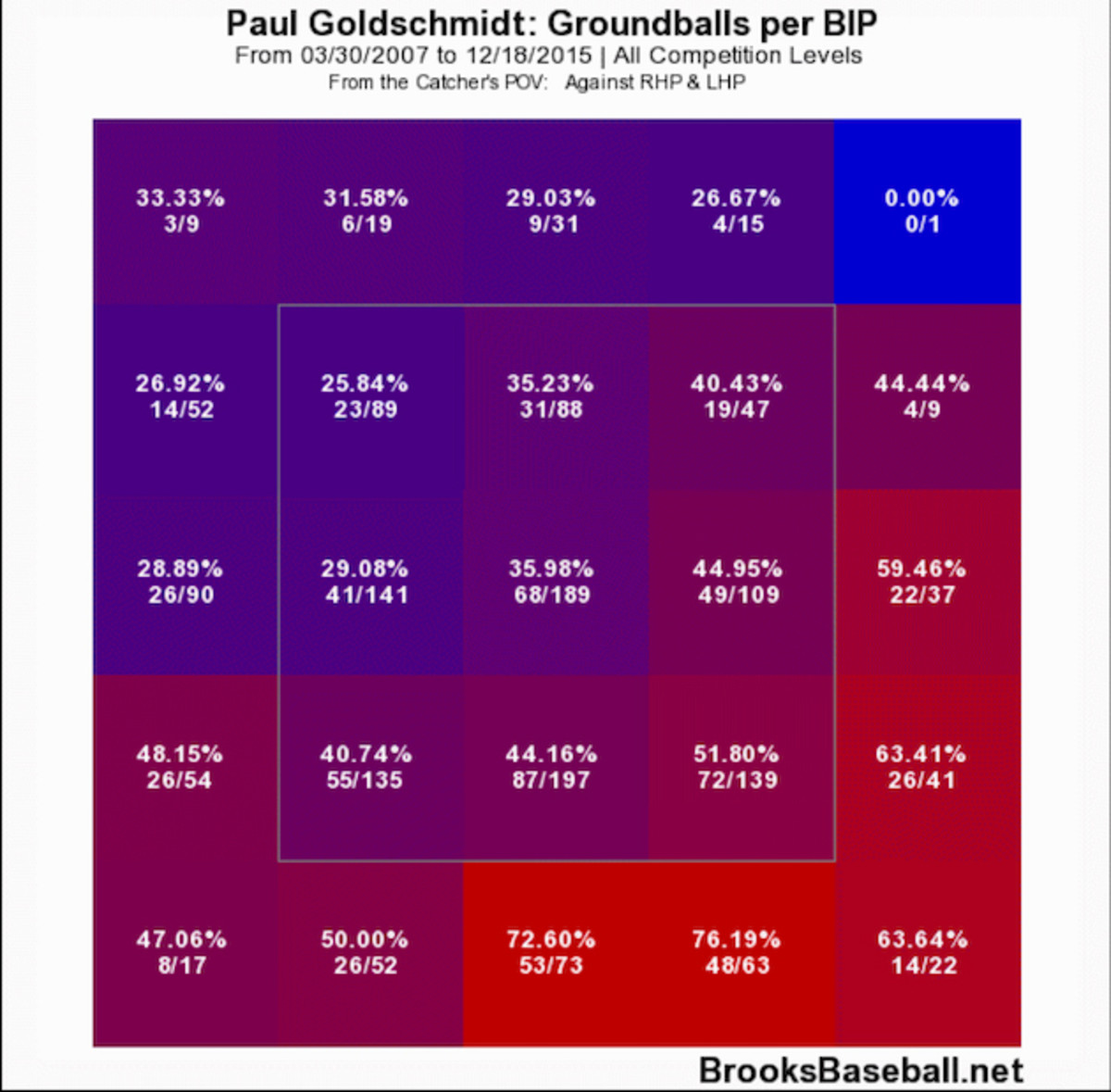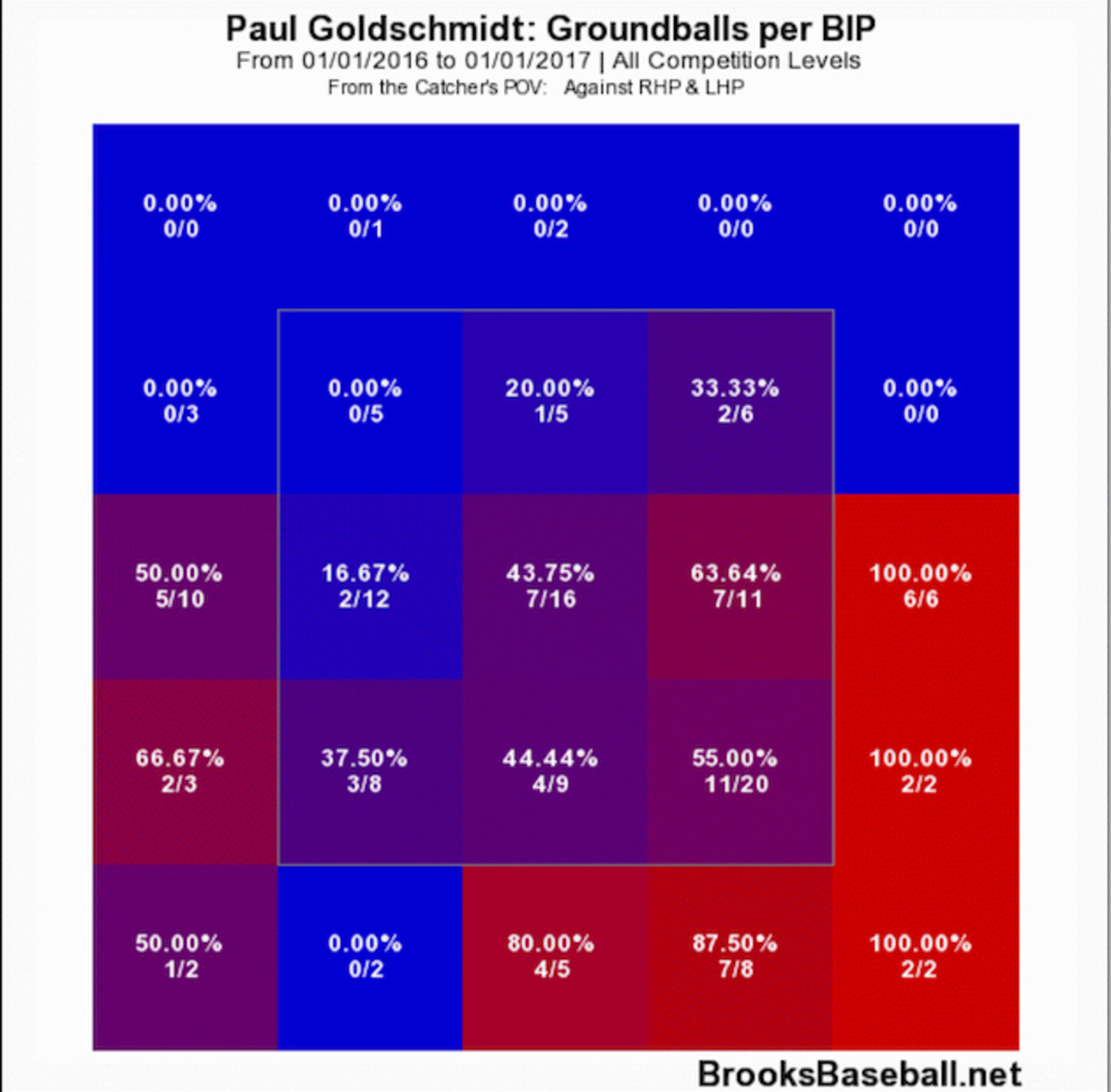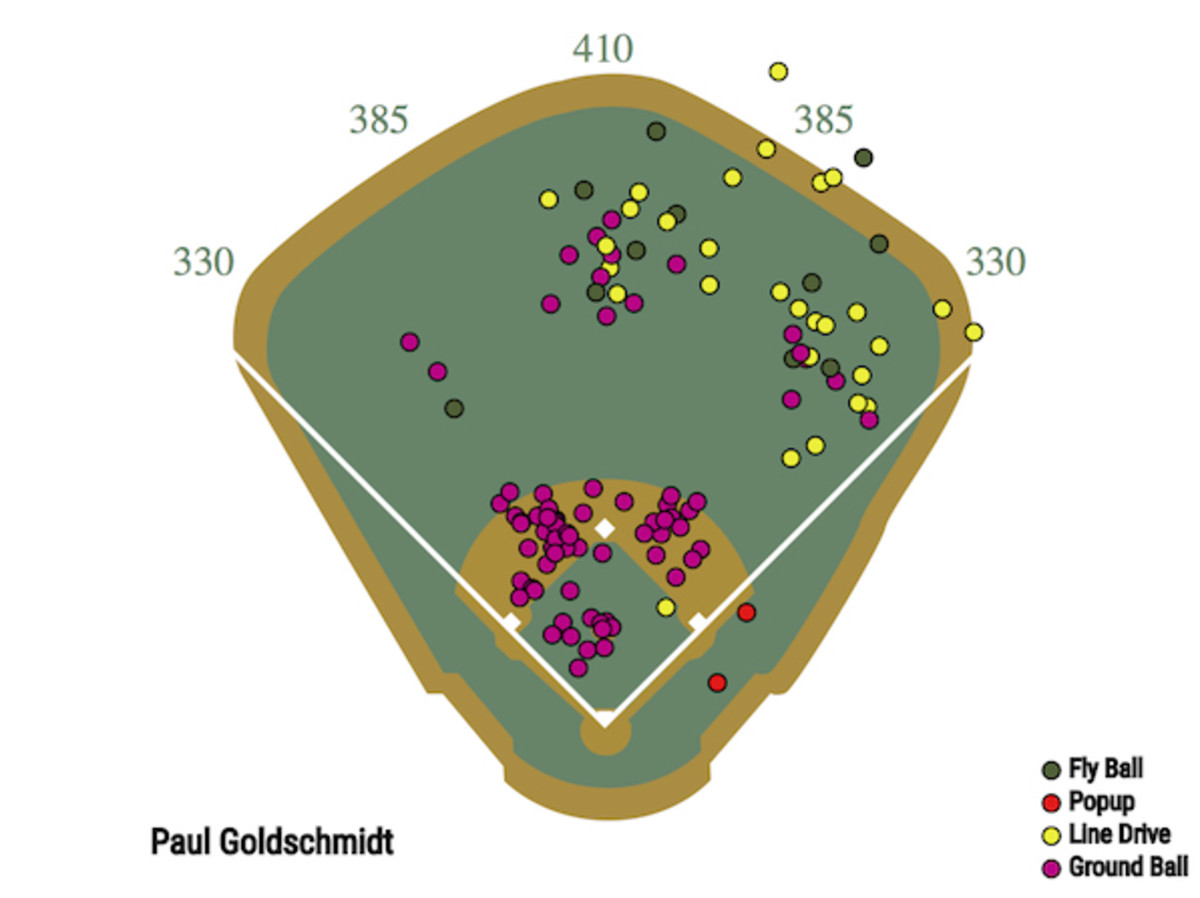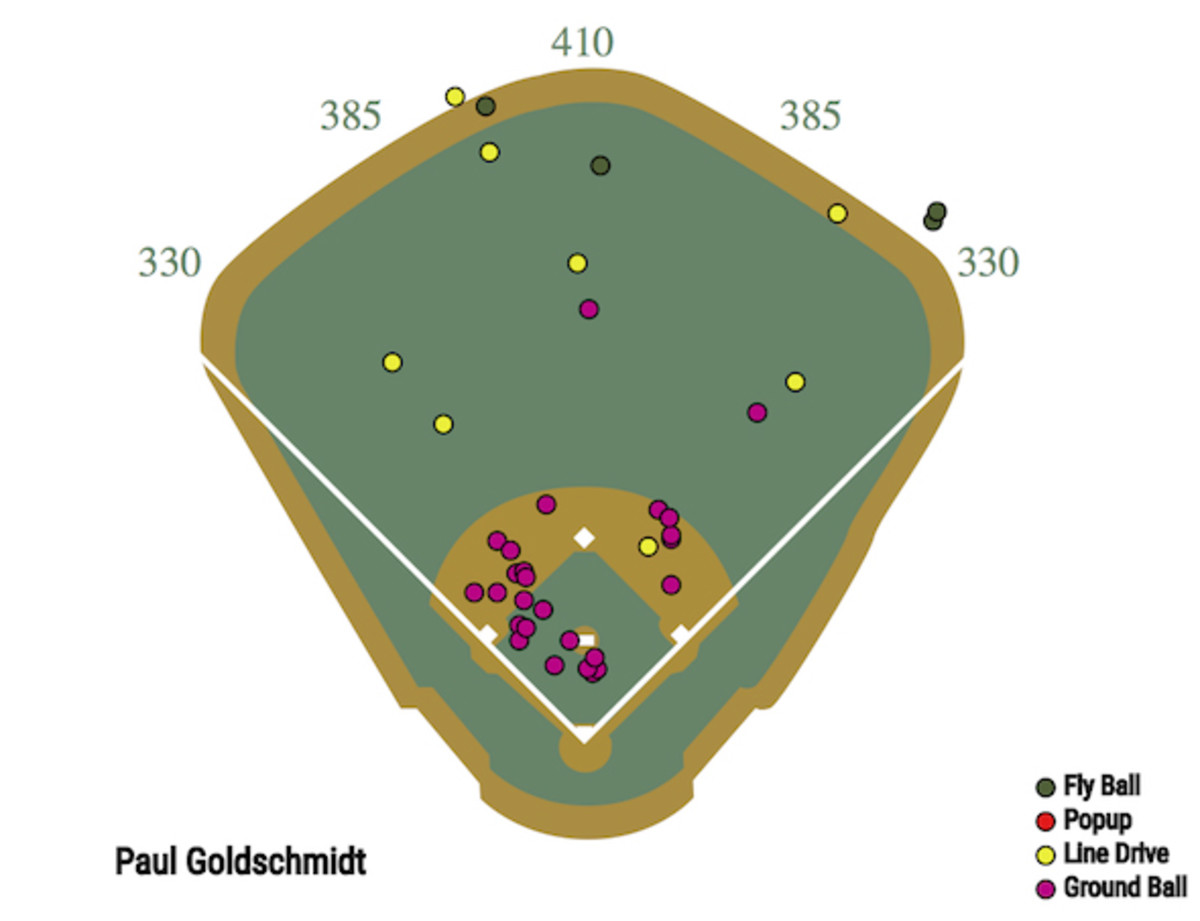What is plaguing Diamondbacks’ Paul Goldschmidt at the plate?

Get all of Doug Farrar’s columns as soon as they’re published. Download the new Sports Illustrated app (iOS or Android) and personalize your experience by following your favorite teams and SI writers.
Paul Goldschmidt owns one of the most bizarre, unexpected slash lines through the first seven weeks of the 2016 season. The superstar and perennial MVP candidate is hitting just .245, which would be a career low by 41 points. He’s slugging .445, which would be a career low by 45 points. His OBP, however, is .412, which would rate as his second-best OBP in his five full major league seasons. There’s undeniably some value in a .245/.412/.445 line, but there’s no shortage of metrics that something’s wrong with the Diamondbacks’ slugger.
Stats reveal that Goldschmidt isn’t hitting the ball as hard as he usually does. His isolated slugging is down to .200, which would be great for some players, but is terrible by his standards. His BABIP is at a would-be career low of .297. Goldschmidt’s ground-ball rate is up, while his line-drive and fly-ball rates are down. Every one of these trends is bad, both on its face and below the surface.
Why Nationals’ Gio Gonzalez likely won’t keep up his strong start
Add it all up, and it shouldn’t be a surprise that Goldschmidt is on track to post career-worst marks in hard-hit rate and soft-hit rate. The former sits at 33%, down from a career rate of 40.5%; the latter is at 21.1%, a full 10 percentage points higher than the soft-hit rate he has amassed in his career. We’re past the point of it being early in the season, especially since batted-ball rates normalize faster than most other stats.
So Goldschmidt is hitting too many grounders and isn’t making nearly enough hard contact. Can we find the root of the problem? Let’s start with Goldschmidt’s ground-ball rate by zone, courtesy of Brooks Baseball. The first profile is for his career through last season, while the second covers 2016.


Intuitively, every hitter in the majors is going to have a higher ground-ball rate on low pitches than high pitches. Goldschmidt, however, has always had a knack for turning low pitches into line drives and fly balls, which lets him do the damage that turned him into a consensus top-five pick. This season, Goldschmidt is hitting far more low and outside pitches on the ground when he puts them in play.
Any time a player has this dramatic a change in his batted-ball rates, you want to see if he’s doing anything different at the plate. Let’s first look at a double Goldschmidt hit off Madison Bumgarner on a low strike in 2015, then a double-play grounder from this season served up by Jaime Garcia. We’ve controlled for pitch location, with both of these pitches low strikes in the middle of zone.
There’s no difference between the stance or swing from 2015 to ’16. He goes into his load relatively early, uses a toe tap as a timing mechanism and finally uncoils the whole apparatus when he’s ready to swing. So swing mechanics are off the table as a cause of Goldschmidt’s spiking ground-ball and soft-hit rates.
There’s one more nugget in Goldschmidt’s batted-ball data, however, that hints a bit more strongly at something being wrong with his swing, even though it might not be easily identifiable by watching him hit. Goldschmidt has put 22.9% of his balls in play to the opposite field—that would be a career low by wide margin. In fact, Goldschmidt has never had an opposite-field rate lower than 28.8%. His 45% pull rate would be a career high by nearly five percentage points.
• WAIVER WIRE: Stash Devon Travis before he returns to the big leagues
Pulling the ball is not inherently a bad thing. Most home runs are hit to the pull side and we are looking for more homers out of Goldschmidt. He has left the yard in 3.9% of his plate appearances, which would be his lowest rate since his rookie year, in which he had 20 jacks in 587 plate appearances (3.4%). What matters is the location of pulled pitches, and that’s where Goldschmidt is getting into trouble.
The following are two different Goldschmidt spray charts on outside pitches. The first is from last season, and the second is from this year.


Goldschmidt is turning an insignificant number of outside pitches into line drives and fly balls this season, and when he does lift those pitches, too frequently they’re going to his pull side. Compare that with last year, when he peppered right-center and straightaway right field with liners and fly balls. Last year, Goldschmidt hit 29 line drives on outside pitches. All but one went to the right side of second base, and even that one was basically to straightaway center. This year, four of Goldschmidt’s eight liners on outside pitches have been to straightaway left or left center.
Astros done? Plus, more on Fielder, Harvey, bad potential rule change
All four of his line drives resulted in hits, and two went for extra bases. The problem, however, is that it’s hard to pull a liner on a pitch on the outer third or off the plate away. More likely than not, a hitter will roll over it for an easy groundout to short or third, and that’s what’s happening most often to Goldschmidt this year. He had 45 groundouts on outside pitches last season. Goldschmidt already has 19 this year in less than one-third of the plate appearances he had a season ago.
There is reason for optimism for Goldschmidt owners that goes beyond, “Well, he’s really good and will probably figure this out.” To begin with, when he does lift the ball, he’s doing so with authority. His HR/FB ratio is 22.2%, which is right in line with last season and is 2.2 percentage points better than his career average. His average fly ball distance is down, but remains impressive at 298.79 feet. His walk rate is up to 21.1%, while his 24% strikeout rate is just a tick higher than his career average
Ground-ball rate may normalize quickly, but if we’re right about him pulling off on too many outside pitches, all it takes for him to turn things around is getting back to driving more of those pitches to the opposite field. We looked at a similarly ugly ground-ball trend for J.D. Martinez in a trade advice column from two weeks ago. Since then, Martinez has hit four homers and three doubles, and has raised his slugging percentage nearly 100 points. The great ones can identify their problems and turn them around in no time. It’s a good bet that Goldschmidt will follow that script.
Hitters to watch this week
Jackie Bradley Jr., OF, Red Sox
You didn’t expect someone else to lead this off, right? Bradley will bring a 27-game hitting streak into action when the Red Sox begin a three-game series with the Rockies on Tuesday. The Red Sox are scheduled to face Jorge De La Rosa, Chad Bettis and Jon Gray when they host Colorado. If Bradley can extend the hitting streak to 30, he’ll then put it on the line against the Blue Jays over the weekend. They’re on track to throw J.A. Happ, Marcus Stroman and R.A. Dickey in the series. Bradley is 40-for-98 and is hitting .408/.487/.786 during the streak.
• Jackie Bradley Jr.’s adjusted swing playing a huge role in hit streak
Giancarlo Stanton, OF, Marlins
Strikeouts are a huge part of Stanton’s reality, but he usually more than makes up for all those whiffs with a significant number of dingers. That has not been the case over the last few weeks. Stanton is in potentially the worst stretch of his career, going 6-for-55 with 28 strikeouts in his last 16 games. In that time, his slash line has fallen to .213/.326/.467 from .274/.391/.632. He had one stretch in which he struck out 13 times in 16 trips to the plate. We’ve seen enough from Stanton to trust that he’ll turn things around, but that hasn’t made this strikeout-laden run any easier for his owners.
Danny Valencia, 3B/OF, A’s
Donaldson right in comments about beanballs, but change will be slow
Valencia’s ownership rate climbed a bit too high for him to be a waiver wire recommendation this week, but we still wanted to flag him for owners in leagues where he remains available. Valencia quietly turned into fantasy-relevant player last year, his age-30 season, hitting .290/.345/.519 in 378 plate appearances. He has carried that on this year, slashing .323/.352/.535 through 155 trips to the plate. After being an occasional player for the A’s over the first five weeks of the season, he has started all of the last 11 games, going 13-for-40 with six homers in that stretch. Valencia should be a player of note in all formats, not just deep ones.
Francisco Lindor, SS, Indians
Is there a more underappreciated superstar in the game today than Lindor? Carlos Correa hogged all the shortstop fanfare a year ago, and then Trevor Story swooped in to steal the headlines during this season’s first few weeks. Now when people talk about all the great young shortstops, they often discuss them as one great monolith. Lindor is enjoying another excellent campaign, hitting .310/.365/.408 with three homers, eight doubles and eight steals in 184 plate appearances, all while playing great defense at the most important position on the field. Lindor saw his five-game multi-hit streak snapped over the weekend, but he remains one of the hottest hitters in baseball.
Carlos Gonzalez, OF, Rockies
Gonzalez got off to an huge start this season, slashing .330/.378/.538 with four homers in April. He has been nothing short of awful in May, hitting .200/.241/.280 with one homer, 18 strikeouts and four walks. He did go 2-for-4 in Colorado’s loss to Pittsburgh on Monday, though he had zero hits in his previous 17 plate appearances heading into the game. Gonzalez has enough of a track record that we can trust him to play most of this season somewhere between his April and May numbers, but his owners might want to think about trying to sell once he starts to turn things around and gives them the ability to do so.
• REITER: How White Sox ace Chris Sale is doing more with less
Prospect watch
Mikie Mahtook, OF, Rays
No one wants to be a 26-year-old prospect. The list of players who have turned into stars in the majors who were still at the Triple A level to start their age-26 season is short. That’s where Mahtook, who was the 31st overall pick in the 2011 amateur draft, found himself at the beginning of this season. Still, there was more reason to believe in him than the typical 26-year-old in the minors.
Mahtook logged 115 plate appearances with the Rays last season, slashing an impressive .295/.351/.619 with nine homers, but that wasn’t enough for him to break spring training with the team. After he hit .333/.416/.487 at Triple A Durham, there was nothing the Rays could do but promote him to the majors. He made his first start of the 2016 season Monday, going 1-for-3 in a loss to the Marlins. With Kevin Kiermaier on the shelf for 8-to-10 weeks after breaking multiple bones in his hand, Mahtook has a chance to not only play mostly every day, but to carve out a role for himself, even when Kiermaier returns. He’s not yet someone fantasy owners should be targeting, but if he shows that the success he had in last year’s cup of coffee wasn’t a fluke, he’ll be on the radar in all formats.
GIF of the week
Never stop doing this, Kevin Pillar.
